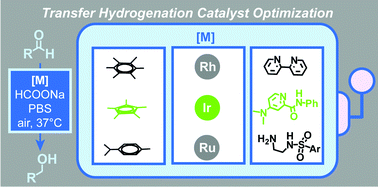Structure–activity relationship study of half-sandwich metal complexes in aqueous transfer hydrogenation catalysis†
Abstract
A systematic structure–activity relationship study was performed to identify the factors that are important to enhancing the transfer hydrogenation efficiency of half-sandwich metal complexes, which is an important class of compounds recently shown to be useful as artificial enzyme cofactors, catalytic drugs, and intracellular catalysts. In general, electron-rich ligands provided catalysts with greater activity and chemical stability than electron-poor ligands under physiologically relevant aqueous conditions. Complexes containing Ir were better catalysts than those containing Ru, Rh, or Os. Kinetic studies by UV-vis absorption spectroscopy revealed that ligand substituent effects could dramatically accelerate the rates of both hydride formation and hydride transfer processes, the latter by up to a remarkable 28-fold. The thermodynamic hydricities of several iridium–hydride species were determined using a hydride exchange method, which showed a strong correlation between the hydride donor strengths of the iridium–hydride species and the transfer hydrogenation yields of their parent complexes. Specifically, this work provides a practical guide for further elaboration of the pentamethylcyclopentadienyl iridium pyridinecarboxamidate catalyst platform. We found that electron-donating groups on the pyridyl ring are conducive to achieving high catalytic rates whereas a wide variety of alkyl and aryl groups on the N-amide moiety are well-tolerated, suggesting that this position might be the best site for conjugation to other functional entities for biological applications.



 Please wait while we load your content...
Please wait while we load your content...